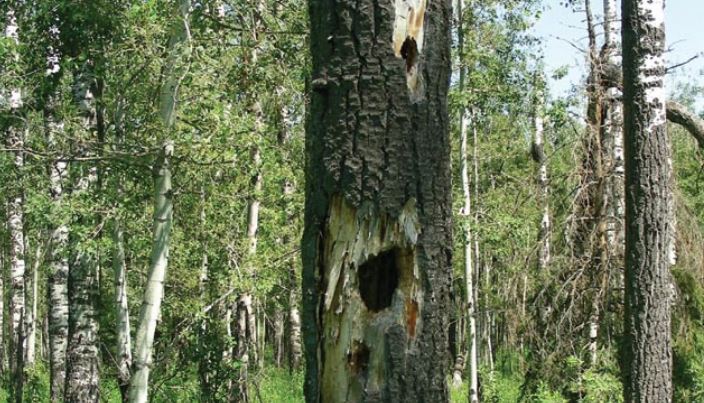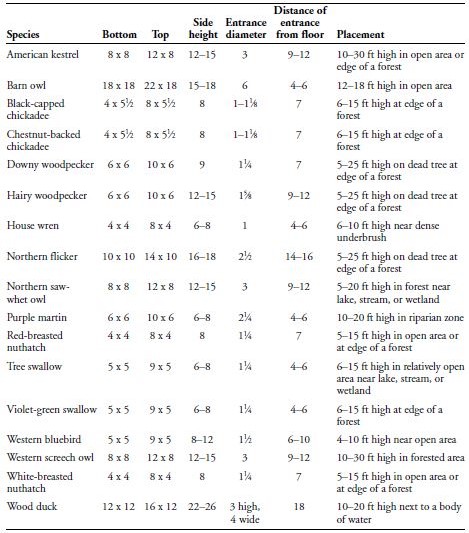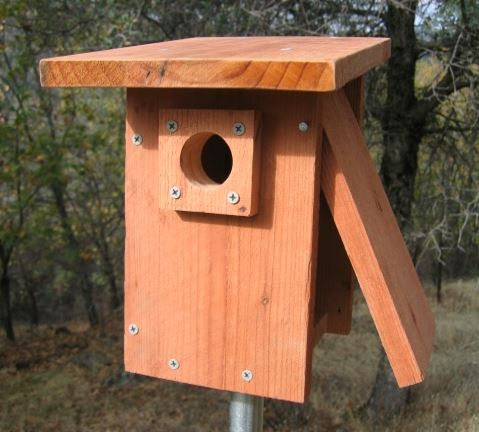Supplemental Nest Sites for Birds
Texas has numerous species of birds that nest in tree cavities (holes) in dead or rotting trees. Unfortunately, suitable nesting sites are often limited, so nest box placement for birds is warranted. When done correctly, placing nest boxes out for songbirds, owls and other birds is a good management practice. Furthermore, this activity is a qualifying practice for landowners maintaining a wildlife exemption (wildlife tax valuation) on their property.
Dead trees are called snags. Though snags are very valuable for wildlife, many snags are often cut down and removed for aesthetic reasons or because they are considered a hazard. Dead trees should be retained when possible as they provide wildlife shelter for a variety of wildlife and insect species. As a result, dead trees also serve as feeding sites for woodpecker and other birds.
If you have some dead trees on your property, then congratulations. Not so much because your trees have died, but because you can use them to provide wildlife habitat. You can also make them safer for you by cutting off their tops and cutting back the branches. The trunks of these trees are still as valuable for wildlife with missing tops and limbs.

Trees & Nest Box Placement for Birds
Dead and rotting trees are ideal sites for tree cavities to develop. Unfortunately, some dead trees must be removed because they are a threat to property infrastructure or people. In other, cases it’s more about the species of the trees present that result in a need for nest boxes for birds. Not all species of trees are created equal when it comes to cavity development.
In some parts of Texas, dominant trees species are not prone to cavity development. In the hill country, for example, one of the more common trees is juniper, commonly referred to as cedar. This tree is unlikely to develop a cavity suitable for a nesting bird. The same can be said of mesquite, which is found around the state. Lands with an abundance of juniper or mesquite are good candidates for the installation of nest boxes.
Lastly, sometimes a tract of land has the right tree species but there are still lacking in tree cavities. This occurs when tree stands are young. It usually takes older, more established woodlands to contain an adequate density of suitable nesting sites. A lack of tree cavities means a lack of nest sites for cavity-dependent birds. Again, the addition of nest boxes for birds is a recommended management activity in these situations.
Building & Buying Nest Boxes
If you have no snags on your land, you can help replace the loss of natural cavities by adding nest boxes for songbirds and other bird species. Nest boxes are a great way to attract birds to your property. They provide birds shelter and a place to raise their young. Some native birds that use nest boxes are chickadees, wrens, bluebirds, swallows, owls, wood ducks and whistling ducks.
Don’t be fooled! There are many kinds of decorative birdhouses for sale. However, they might not be right for use. Before you buy a birdhouse, be sure it has the correct dimensions and other features important for birds’ welfare and safety. Some nest are made from materials that are not suitable. A nest box with a metal roof gets mighty hot when it’s in the sun.
You can build your own nest boxes for birds if suitable boxes are not readily available. Nest boxes for eastern bluebirds are probably the most commercially available box. Some good boxes exists, but some are junk. Building your own nest box can be fun if you like do-it-yourself type projects. It’s a great feeling watching young bird emerge from a nest box that you built yourself. Let’s discuss a few box building tips.
The best hardware for nest boxes is brass or galvanized wood screws or galvanized nails. Screws are recommended, because they make it easier to fix mistakes and replace damaged parts down the road. Do not use treated, stained, or painted lumber. Toxic fumes may harm the birds, and paint fills the pores and reduces the insulating capacity of the wood.
Exterior plywood that is at least 5/8-inch thick will work. However, it is recommended that at least 3/4-inch-thick pieces of cedar, cypress or redwood be used. Cedar, cypress and redwood have natural preservatives. Always select straight boards with few knots and split ends. If you want a more natural-looking box, you can attach pieces of bark and moss to the outside.
Nest Box Design for Birds
Nest boxes can be very simple in design. The most important features are the size of the box and the entrance hole. Check that the nest box design is right for the bird species you wish to shelter . The table below shows nest box sizes for birds. Note, some of these birds are not found it Texas, but we have similar species. For example, substitute eastern screech out for western screech owl and eastern bluebird for western bluebird.

There is a saying in wood working, measure twice and cut once. Cut the wood into pieces with the correct dimensions. Use the table above for the dimensions and specifications for a variety of bird nesting boxes. For birds not listed, a quick search of the web will often produce results with the recommended box dimensions.
The easiest way to make the entrance hole for the front of a nest box is to use a hole saw of the correct size attached to a power drill. Otherwise, you can make an entrance hole with a jigsaw after drilling a starter hole. Ensure that entrance the dimensions are correct and the entrance hole is smooth.
If possible, pre-drill screw hole placement with a drill bit slightly smaller than the screw or nail. This prevents the wood from splitting. Drill all holes before you assemble the box. It is recommended that you roughen the inside surfaces of the box pieces with a wood rasp or sandpaper before placing them all together.
Nest Box Details
Cut 1/8-inch grooves on the inside of the front panel with an awl or hammer claw. These grooves enable young birds to climb out of the box when they are ready to leave the nest (to fledge). Drill several 1⁄4-inch holes in the bottom of the box to allow water to drain, and at least two 1⁄4-holes in the sides of the box near the top for ventilation.
Maintenance is just as important as nest box placement for birds. Here’s a tip to make box access a snap. Use two pivot screws or nails to pin the top of one of the sides. This allows it to hinge open so you can clean the box inside. Be sure the pivot screw on the opposite side is at the same level as the one in front, so the side will open easily. It is recommended that you use a single screw to keep the swing door closed. Alternatively, you can use two screws and a wire to keep the side closed firmly.
Where: Nest Box Placement for Birds?
Nest box placement is important. It’s important for both you and the birds. Place a nest box where it is easy to mount, clean, and inspect. Attach it to a sturdy support at least 4 feet off the ground, in a spot that allows birds safe and easy access.
Refer to the table again for nest box placement height. Ideally, select plant communities that are suitable for the bird species. Put the box in a spot that gets morning sun but is protected from afternoon heat. The east or north sides of a woodland edge or clump of trees/brush are often good locations. Do your best to ensure the nest box is placed in such away that heavy winds so rain won’t be blown into the entrance hole.
It may take a while for birds to use your nest box. Don’t be discouraged! If birds haven’t used your box after the first year, try moving it to a different spot. Sometimes a different placement is all that is needed. In addition, try putting up several boxes. This gives birds more choices and you’ll find out which spots they prefer. Then, you can replicate the setup.
Finally, it is recommended that you line the bottom of your bird nesting box with an inch of nesting material such as wood shavings or wood chips. Some birds will use the material itself for nesting, and others will build their nest on top of it. Do not use sawdust, because it soaks up water and gets matted down.

When to Place Out Nesting Boxes
In general, the best time to place out nest boxes for birds is in February or March. This is perfect for birds that begin nesting in early spring. For advance birders, observe the behavior of the species you’re interested in. Note their arrival time and when they start using the nest box.
In addition, continue to monitor your nest box to be sure predators or competitors do not become a problem. Nest boxes are often attractive to non-native birds. Depending on how you want to handle the situation, you may choose to take action.
In Texas, non-native birds are not protected under law. Cavity nesting birds that can controlled by any means include English house sparrows, European starlings, and Brown-headed cowbirds. Brown-headed cowbirds are nest parasites and landowners can become certified to trap and dispatch them in Texas.
Discouraging Box Use by Non-Native Birds
In addition to the aforementioned non-native and parasitic bird species, squirrels can also be a problem with larger nest boxes. Squirrels are cavity nesters too and often compete for nest boxes intended for birds. The size of the entry hole is the most important way to keep out larger species.
For example, starlings cannot fit into a box with a 11⁄2-inch or smaller opening. House sparrows defend their nests very aggressively and are difficult to exclude. Remove their nest again and again until they give up and go somewhere else. They can also be trapped and dispatched or hunted.
To prevent competing animals from enlarging the entrance hole, attach a piece of metal with a hole the same size as the entrance on the front of the box. Be sure to file down the edges so they are not sharp. This will keep larger birds and other wildlife out. Nest boxes placed near developed areas are more likely to have issues with unwanted guest. Nest box placement for birds in more rural areas are less likely to attract squatters.
Protecting Nesting Birds from Predators
Raccoons, snakes, cats, crows, starlings, and house sparrows are the main predators of nesting birds. In general, cavities and nest boxes offer good protection for birds. When sized appropriately, boxes help nesting birds play defense. Even with that in mind, there are additional things you can do to reduce the impact of predators.
To further protect the entrance, make a predator block. Attach a block of wood 1-inch thick with a hole the same size as the entrance hole over the front of the box. This creates a short tunnel, which helps prevent other creatures from reaching easily inside the box. Be sure to sand the hole in the block to keep it smooth and aid bird access.
A baffle is another kind of predator guard. Place a baffle around a tree or post above or below the nest box to keep mammals from gaining access to it. You can buy baffles at specialty bird shops or home and garden stores. Or, you can create them from a piece of sheet metal or a stovepipe. Baffles are not foolproof, but they do make it more difficult for predators.
Lastly, be sure there are natural or artificial perches near bird nest boxes. A small dead tree, an open branch on a larger tree, a pole, other vegetation, or a manmade structure will help nesting birds survey the area before entering the nest box. Do not place perches on nest boxes, as they allow easier access for predators.
Cleaning Bird Nesting Boxes
Installing nest boxes for birds is the first step, but it takes periodic maintenance to get the most of your nest boxes. The best time to clean nest boxes is during late winter before birds begin nesting. From experience, I can tell you that a nice brisk morning is preferred. In Texas, wasps often overwinter in nest boxes, so a cool morning ensures you have the advantage!
Do not try to clean or fix a nest box while birds are nesting in it. When you clean a nest box, be sure to remove old nesting material, unclog drainage holes, entrance holes, and air holes. In addition, make sure screws and nails fit properly. Do not use insecticides (even if wasps are present). If necessary, wash
out the box with water to remove bird droppings or insects.
Review: Nest Box Placement for Birds
It summary, Texas has numerous species of birds that nest in tree cavities. On many properties, suitable nesting sites are often limited. A lack of suitable nesting sites may result in some birds avoiding use of a property. In addition, a lack of nesting sites equates to lower reproduction within some bird species.
A good management activity is nest box placement for birds, which can help land managers overcome habitat deficiencies. The addition of nest boxes is also a management activity for wildlife exemption in Texas, which falls under providing supplemental shelter for wildlife. Landowners can maintain an agricultural tax valuation by performing active wildlife management each year.